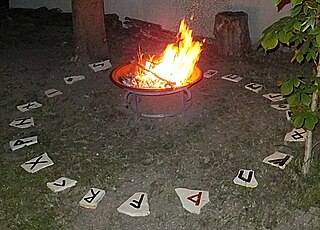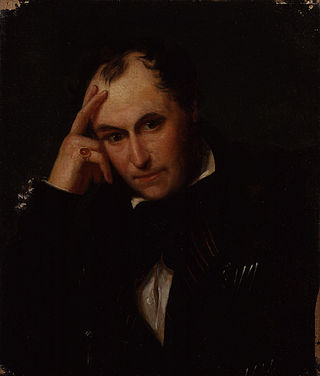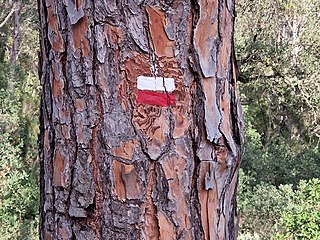
Andalusia is the southernmost autonomous community in Peninsular Spain. Andalusia is located in the south of the Iberian Peninsula, in southwestern Europe. It is the most populous and the second-largest autonomous community in the country. It is officially recognised as a historical nationality and a national reality. The territory is divided into eight provinces: Almería, Cádiz, Córdoba, Granada, Huelva, Jaén, Málaga, and Seville. Its capital city is Seville. The seat of the High Court of Justice of Andalusia is located in the city of Granada.

Rail transport in Spain operates on four rail gauges and services are operated by a variety of private and public operators. The total route length in 2012 was 16,026 km.

A brazier is a container used to burn charcoal or other solid fuel for cooking, heating or cultural rituals. It often takes the form of a metal box or bowl with feet. Its elevation helps circulate air, feeding oxygen to the fire. Braziers have been used since ancient times; the Nimrud brazier dates to at least 824 BC.

The taifas were the independent Muslim principalities and kingdoms of the Iberian Peninsula, referred to by Muslims as al-Andalus, that emerged from the decline and fall of the Umayyad Caliphate of Córdoba between 1009 and 1031. They were a recurring feature of al-Andalus history.

Murcian is a variant of Peninsular Spanish, spoken mainly in the autonomous community of Murcia and the adjacent comarcas of Vega Baja del Segura and Alto Vinalopó in the province of Alicante (Valencia), the corridor of Almansa in Albacete. In a greater extent, it may also include some areas that were part of the former Kingdom of Murcia, such as southeastern Albacete and parts of Jaén and Almería.

Both the perceived nationhood of Spain, and the perceived distinctions between different parts of its territory derive from historical, geographical, linguistic, economic, political, ethnic and social factors.

Richard Ford (1796–1858) was an English travel writer known for his books on Spain. Born in Chelsea into an upper class family and educated at Oxford, he first moved to Spain in 1830, where he travelled extensively and collected notes and drawings. Upon return to England, he wrote an account of his journeys in A Handbook for Travellers in Spain, first published in 1845, described as one of masterpieces of the travel literature genre. An erudite art collector, he befriended many important art and literature figures of his time. Ford was himself skilled in drawing himself, and made illustrations for his own and his friends' books.

Carteia was a Phoenician and Roman town at the head of the Bay of Gibraltar in Spain. It was established at the most northerly point of the bay, next to the town of San Roque, about halfway between the modern cities of Algeciras and Gibraltar, overlooking the sea on elevated ground at the confluence of two rivers, nowadays called Guadarranque and Cachon.

John Murray III (1808–1892) was a British publisher, third of the name at the John Murray company founded in London in 1777.

Murray's Handbooks for Travellers were travel guide books published in London by John Murray beginning in 1836. The series covered tourist destinations in Europe and parts of Asia and northern Africa. According to scholar James Buzard, the Murray style "exemplified the exhaustive rational planning that was as much an ideal of the emerging tourist industry as it was of British commercial and industrial organization generally." The guidebooks became popular enough to appear in works of fiction such as Charles Lever's Dodd Family Abroad. After 1915 the series continued as the Blue Guides and the familiar gold gilted red Murrays Handbooks published by John Murray London including the long running Handbook to India, Pakistan, Ceylon & Burma which concluded with the 21st edition in 1968 before changing from the original format of 1836 to a more modern paperback edition of 1975.

The Traveller; or, a Prospect of Society (1764) is a philosophical poem by novelist Oliver Goldsmith. In heroic verse of an Augustan style it discusses the causes of happiness and unhappiness in nations. It was the work which first made Goldsmith's name, and is still considered a classic of mid-18th-century poetry.
The following is a chronology of the history of the city of Granada, Andalusia, Spain.
The following is a timeline of the history of the city of Córdoba, Andalusia, Spain.
The following is a timeline of the history of the city of Murcia, Spain.
The following is a timeline of the history of the city of Cádiz, Spain.
The following is a timeline of the history of the city of Alicante, Spain.
The following is a timeline of the history of the city of Almería, Spain.

The GR 92 is part of the extensive GR footpath network of paths, tracks and trails in Spain. It will eventually run the length of the Mediterranean coast of Spain, from Portbou, on the border with France to Tarifa, the most southerly point of Spain. In doing so it will pass through the autonomous communities of Catalonia, Valencia, Murcia and Andalusia. The sections in Catalunya and Murcia are complete and fully signposted, but work is still in progress on the sections in Valencia and Andalusia, and sources differ on the eventual length of the path.
The history of the territorial organization of Spain, in the modern sense, is a process that began in the 16th century with the dynastic union of the Crown of Aragon and the Crown of Castile, the conquest of the Kingdom of Granada and later the Kingdom of Navarre. However, it is important to clarify the origin of the toponym Spain, as well as the territorial divisions that existed previously in the current Spanish territory.












